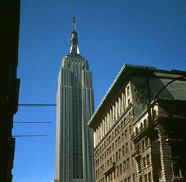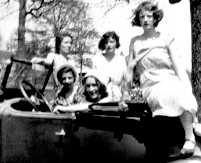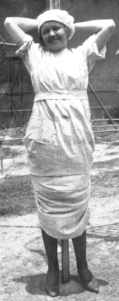Movies were hot; parlor games and board games were popular. People gathered around radios to listen to the Yankees. Young people danced to the big bands.
In the 1930's the "land of opportunity" became the "land of desperation." The Great Depression devastated many in the Dust Bowl area. Between 1929 and 1932, the income of the average American family was reduced by 40%, from $2,300 to $1,500. Instead of advancing in life, survival was top priority. Everyday life was changed, but during this decade democracy in the United States continued to prevail. While other democracies, such as Germany and Italy, fell to dictatorships, the United Stated and its constitution survived. Money was scarce because of the depression, so people did what they could to live happier lives.
The arts were dominated by the Great Depression. Many of the nation's most memorable skyscrapers were completed in the early 1930's.
 empire sttate buiding
empire sttate buiding
Cash was in short supply, so many parents were unable to provide their children with the necessary clothes, supplies, and textbooks to attend school. Taxes, especially in rural area, went unpaid. School terms were shortened, salaries were cut, and classes were small. Many times classes consisted of more than just one grade level.
 FADS & FASHIONS
FADS & FASHIONS
Since incomes were so small, people had to look to inexpensive leisure pursuits. President Franklin D. Roosevelt helped make stamp collecting a popular hobby. The money and property game, Monopoly, was introduced by the Parker Brothers, and twenty thousand sets were sold in one week. Gambling increased as many tried to increase their income. The interest for baseball also grew. Stars like Lou Gehrig and Joe DiMaggio brought fans to the stadiums. Those who could not attend the games listened to their radio for the play-by-play. The 1932 Winter Olympics in New York renewed interest in winter sports.
Hollywood movie stars such as Bette Davis and Greta Garbo set fashion trends in dresses designed by Adrian and Muriel King. Clothes had to last a long time, so styles did not change every season. The use of the zipper became wide spread for the first time because it was less expensive than the buttons and closures previously used. The 1930's is also known for having different hem lengths for different times of the day.
